
![Ver [Vincent, MS; 1285] en referencias bibliográficas. Libro abierto, hojas de plata, filo de oro, guardas de gules, tapas de sable.](../css/Libro.Bibliografia.png)
Vincent, MS; 1285
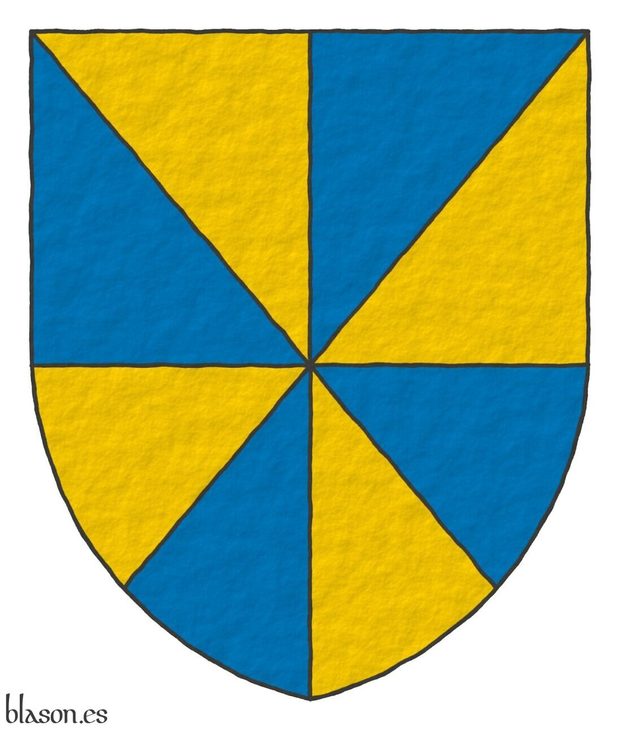
Vincent Manuscript, in English, usually written as «MS Vincent, 164 ff.1-21b», also called [St. George's Roll; 1285], it is in the College of Arms, London, containing 677 painted coats of arms, it is an English roll of arms dating from c. 1285.
Bibliographical reference of century XIII.
Classification: Armorial roll, Manuscript and In color.
Author: unknown.
Bibliographic reference mentioned in the following articles:
- Adam de Cretingges
- Bartholomew de Yattendon
- Edmund de Bassingburnn
- Howel ap Res
- James de Sottone, le Fitz
- Joan de Okinton
- John de Beauchamp
- John de Ladbrooke
- John le Sturmy
- Nicholas Malmains
- Norman Darcy
- Ricardo de Mandeville
- Robert de Malet
- Simon de Crombe
- Simon de Ver
- Simon le FizSimon
- St. George's Roll; 1285
- Thomas Roscelyn
- Thomas de Werblintone
- Thomas le FizThomas
- William Bardolf
- William de Ferrers, Earl of Derby
- William de Hondeshacre


![Ver [Wijnbergen; 1265] en referencias bibliográficas. Libro abierto, hojas de plata, filo de oro, guardas de gules, tapas de sable.](../css/Libro.Bibliografia.png)
Wijnbergen; 1265
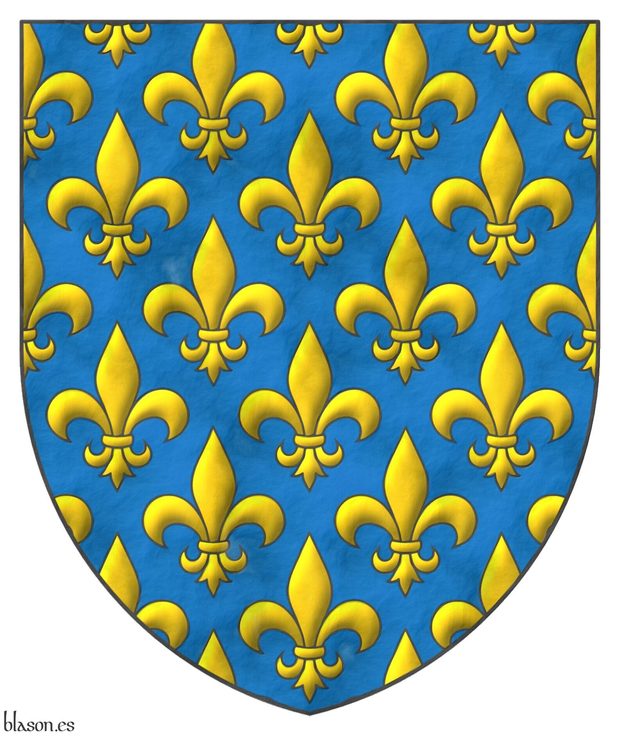
Wijnbergen, unknown authors, «Wijnbergen Armorial», currently located in The Hague and owned by the Royal Dutch Society of Genealogy and Heraldry, Île-de-France, 1265.
This armorial is called «Wijnbergen» because it was named after one of its early owners, and the names of its authors are unknown. I have retained this name in the key to this bibliographic reference for easier identification.
Among known manuscripts, it is the oldest armorial of French heraldry.
It is composed of 15 parts, although some authors divide it into 23, belonging to 2 different temporal stages of creation: a 1st stage from 1265 to 1270 and a 2nd stage, more difficult to date, from 1270 to 1285.
The armorial is written in French and contains a total of 1,312 coats of arms, of which 256 belong to the 1st stage and 1,056 to the 2nd stage.
Those of the 1st stage belong to the vassals of the Île-de-France under the reign of Luis IX de Francia, Saint Louis King of France.
Those of the 2nd stage, probably already under the reign of Felipe III de Francia, contain coats of arms from Normandy, Anjou and Poitou, Lorraine, Germany, Artois, Champagne, Vermandois, Brittany, Beauvais, Burgundy, Brabant, Hainaut (Belgium), Flanders, and finally, the coats of arms of 25 kings, mainly European.
Bibliographical reference of century XIII.
Author: Wijnbergen, Anonymous.
Bibliographic reference mentioned in the following articles:
External links:


Martos García, Juan Carlos
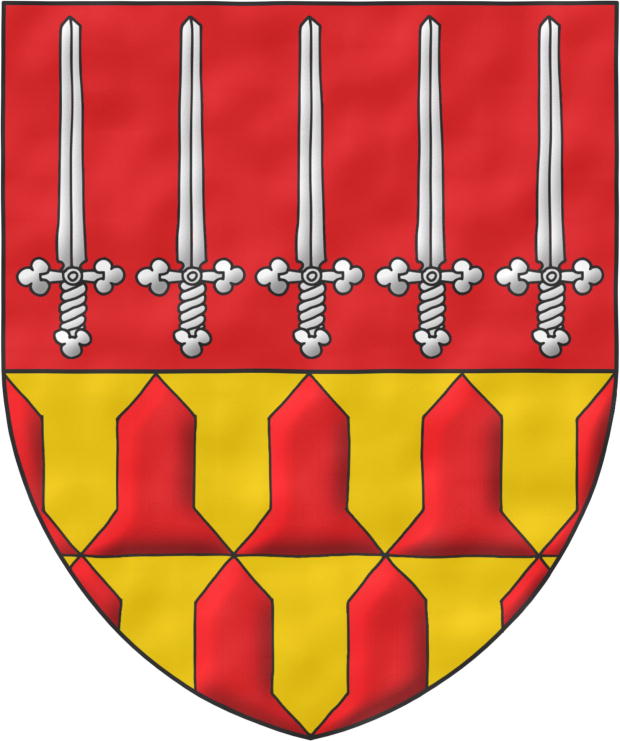
Party per fess: 1 Gules, five Swords Argent, erect, in fess; Vairy or and gules gules and or.
Escudo cortado: 1o de gules, cinco espadas de plata, alzadas, en faja; 2o verado de oro y gules.
Symbology
There are 6 swords raised to defend the truth, symbolised by the vairy fur, and no matter how much time passes, they will be proud and erect until the truth triumphs.
Blazon keywords: Party per fess, Gules, Or, Argent, Five, Sword, Vairy, Point upwards and In fess.
Style keywords: Pointed, Illuminated, Outlined in sable and Watercolor.
Classification: Created, Personal and Coat of arms.
Bearer: Martos García, Juan Carlos.


Video, drawing a helm
Based on the stechhelm of John the Constant (Saxony, ca. 1500). The stechhelm is a kind of helm primarily used by mounted knights for tournaments, since 1400 to 1525.
The music is «Hot Swing» by Kevin MacLeod.
Credits: Kevin MacLeod es el autor de la música.
Blazon keywords: Helm.
Classification: Video.
Bearer: Martos García, Juan Carlos.


Bearers of the coat of arms by name
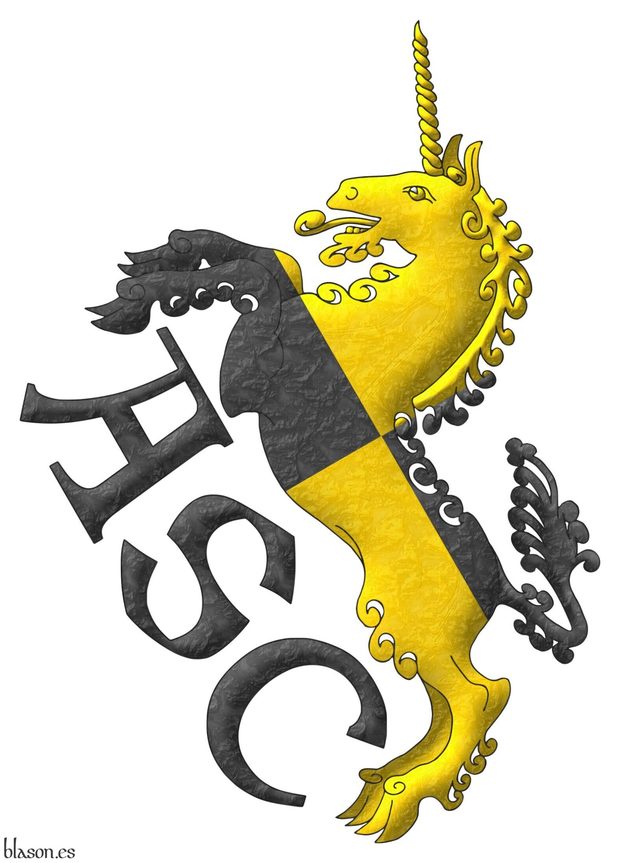
Index of the bearers of the coats of arms ordered alphabetically by name of the bearer:
~ A ~
- Abbasi, Tariq
- Adrian V
- Alarcon of Cantabria, lineage
- Alborán, Sea of
- Alcantara, Cavalry Regiment
- Alea Capital
- Alfonso IX of Leon
- Alfonso VIII of Castile
- Almeria, city of
- Almorrabides of Navarre
- Alphonse X of Castile
- Altnau, Yuri Alexander
- Alu, Graziano
- Anderson of Erbury
- Angueira Duro, Jesus
- Appleton, David B.
- Aragon
- Araneta, lineage
- Aras Quirce, Manuel Maria
- Argote de Molina, Gonzalo
- Argudo of Guipuzcoa, lineage
- Argüello of Extremadura, lineage
- Arithmetic
- Arjona Berrocal, Rubén
- Arrano Beltza
- Artillery Combat School of the Swedish Army
- Aspe, Julio Hector
- Asuncion and de la Asuncion, lineages
- Aybar of Navarre
~ B ~
- Bailleul, commune of
- Balaguer, municipality of
- Balchin, Robert George Alexander
- Baldovino from Venecia, lineage
- Barrio Alto of Mon'Tarena
- Barrio Bajo of Mon'Tarena
- Barrio de los Quereres of Mon'Tarena
- Barrio del Artista of Mon'Tarena
- Baztanes of Navarre
- Beatrice of Swabia
- Bedgood, Alvin J.
- Bella, Giovanni de
- Bendel, Nathaniel
- Benedict XII
- Benedict XIV
- Beninger, Manuel
- Berenguela of Castile
- Berenguela of Castile, Infanta
- Bergamo
- Berlin
- Bermejo Fernandez-Briceño, Francisco Jose
- Berry of Molland
- Berry, Austin Charles
- Berry, John
- Bessières, Jean-Baptiste
- Blanchefort, Bertrand de
- Bosnia and Herzegovina
- Boteler of Warrington
- Boyd of Scotland, lineage
- BPAC I
- BPAC II
- Brady, John
- Breu, Stephan Urs
- Brim-DeForest, Brady
- British Monarchy
- Buffenbarger, Herbert Leo
- Bunyoro-Kitara
- Burgos, University of
- Burr, lineage
- Byrne, Margaret
~ C ~
- Cáceres, Province of
- Candasnos, municipality of
- Castile and León
- Castilla-La Mancha
- Categories of heraldry
- Ceballos of Cantabria, lineage
- Central Military Region
- Cerda, Carlos de la
- Ceuta
- Charles Dunne, Chas
- Charles V of France
- Charles VII of France
- Clement V
- Clement XII
- Clermont, Robert of
- Club Ecuestre Val'Quirico
- Colebrand, William de
- Congregación del Oratorio de San Felipe Neri de Alcalá de Henares
- Correa, Lorena
- Coulot, Fabian
- Craon, Robert de
- Crepsi
- Cristina, The Knights of
- Csernely
~ D ~
- Del Fabbro Universidad
- Dubai Office of the European Chamber of Digital Commerce
- Dukat, family of Milos
- Durkan, John Paul
~ E ~
- Edmund Plantagenet
- Edward I of England
- Edward II of England
- Edward IV of England
- Egado, lineage
- England, Kingdom of
- Ermengol IX of Urgell
- Eschenlauer, Marc
- Escutia Sánchez, María Dolores
- España Herranz, Angel
- Espeja Avieda, Alejandra
- Espinosa, Diego
- Eugene IV
~ F ~
- Farnese, Alessandro
- Ferdinand II of Leon
- Ferdinand III of Castile
- Fernández de Córdoba y Carrillo, Diego
- Fernandez de Cordoba, Gonzalo
- Fernández-Cortés y Fonseca, Javier
- Flor, Roger de
- Francis I of France
- Francisca Aras Quirce
- Frank, Markus Hermann
~ G ~
- Gangoiti, lineage
- García Martínez, Daniel
- Garcia-Bosch-de Morales-de Sola née Adriaensen, Heidi
- Georgia
- Germany, Federal Republic of
- Giaimo di Prizzi, Carmen
- Giannelli and Mariana von Atzingen Gorga, Alessandro
- Gifra, Vittorio
- Gittel Bas Reuven, Malka
- Globe, Richard
- Godfrey V, Count of Anjou
- Gómez Morillo, Antonio José
- González Lara, Rubén
- González López, Manel
- Gozo
- Graaf, Jay Geoffrey De
- Granada, Soberana y Muy Noble Orden de la
- Gräupl, Edwin
- Gregorio Lanzagorta Llaguno
- Gregory X
- Grenville, Thomas
- Grzeszkowiak, Tomasz Arkadiusz
- Guallini, Mario Antonio
- Gudja, municipality of
- Guebara of Navarre
- Gummersbach, Peter Ferdinand
- Gutiérrez Benítez, Jose Manuel
~ H ~
- Haguenau
- Halkosaari, Heikki
- Hartemink, Ralf
- Harten, von
- Hatsis, Mark Antony
- Henry II of England
- Henry III of England
- Henry of Castile, Infante
- Hérail, Gilbert
- Herndon, family of Paul and Kari
- House of Hohenzollern
- Howard II, Dr. James Patrick
- Hradec Králové Region
~ I ~
~ J ~
- James I of Aragon
- James II of Urgell
- Jamilena
- Janovsti of Janovic of Czechia, lineage
- John I of England
- John XXI
- Juchter van Bergen Quast, Rudolph Andries Ulrich
~ K ~
- Kane, Kathleen
- Kasparek, Rick
- Kingdom of Jerusalem
- Knox, Kelly Kathleen
- Krouse, Chad Michael
- Kupang, Royal House of
~ L ~
- Lancefield, Rex
- Lanzagorta Aras, Juan
- Lanzagorta Escutia, Juan Bautista
- Lanzagorta Escutia, Miguel Francisco
- Lanzagorta Ochoa, Ixai
- Lanzagorta Vallín, Juan
- Lanzagorta-Escutia, marriage
- Larkin, Kevin
- Larrosa Gil, Francisco Domingo
- Lasuncion Patus, Francisco Javier
- László Gábor
- László Linnet Regina
- Latidos Podencos
- Lauria, Roger de
- Laydin, lineage
- Lazaro of Aragon, lineage
- Leonor de Aquitania
- Leonor Plantagenet
- Leonor Princess of Asturias
- Lete of Navarre
- Lincoln's Inn, The Honourable Society of
- Lindsay of Scotland, lineage
- Lindsay of the Byres, lineage
- Liu-Lecomble, Laurent
- Lloscós y Soldevilla, Guilaberto
- Lopez Linares, Barbaro Jonathan
- Loubet del Bayle, Jean-Christophe
- Louis IX of France
- Lucca de Anaya, Nilda Ernestina
- Luchoro and Darryn Carlo, Roberto
- Lucius III
- Lukas Podlipny
~ M ~
- Manning, Baz
- Marinanza, Marilena
- Mark of Germany, lineage
- Mark, County of
- Martos García, Juan Carlos
- Mauleón of Navarre
- McCarthy, Eugene
- McCartney, Michael
- McMillan Bell of Auchinreoch, Andrew Ronald
- Mediterranean, Sea of the
- Merante Critelli, Luigi
- Milian, family
- Moguer, municipality of
- Molay, Jacques de
- Montbard, André de
- Monteagudo of Navarra
- Montesa, Cavalry Regiment
- Morgan, Eóin S.
- Morgan, Michael W.
- Mortés, Jean
- Muscat, John
~ N ~
- Nastri, Marcio Vieira
- Navarre
- Nelson, Matthew
- Noblemen of Navarre
- Normand Delfin, Jacques William
- Northam, Jason Landers
~ O ~
- Odysseus of Ithaca
- Ormazabal of the Basque Country, lineage
- Ormazabal-Lazaro, family
- Oschoven of the Rhin
- Osona, lineage
- Otxoa Magaña, Teresa
- Oyervides Ochoa, Luis Gerardo
~ P ~
- Patus, lineage
- Peraza of Cantabria, lineage
- Pérez de Bartolome, Ignacio
- Persad, Ria
- Pesquera de Ebro
- Peter II of Urgell
- Peter IV of Aragon
- Peñafort, Universidad
- Philip III of France
- Philip of Castile, Infante
- Pius V
- Ponce I of Urgell
- Pons Paneque, Jonathan
- Portugal
- Postolovski, Dario
- Pototsky, Yaroslav
- Power, Guy Harold
- Prato di Arnesano, Marquis
- Pujol, Ignasi
~ Q ~
~ R ~
- Rada of Navarre
- Rage from Discord
- Ramon Berenguer IV, Count of Barcelona
- Rawson, Lineage
- Rehberger, Alena
- Reyes, Elijah
- Rica II, Nick Allen
- Ricardo de Mandeville
- Richard I of England
- Richard, Richard
- Rodelo lineage from Galicia
- Romanet, Catherine de
- Romero, Reynaldo
- Rothstein, lineage
- Ruiz Porras, Antonio
~ S ~
- Sainte Croix de la Sabliere, Jean-Yves de
- Sales, Robert Edward
- Sánchez de Perella, Alfonso
- Sancho IV of Castile
- Sancho of Castile, Infante
- Santiago-Vazquez, Lory
- Savoy, Duchy of
- Scotland
- Sendat, Jean-Philippe
- Shakespeare, William
- Shorey, David Ryan
- Shriner, Sean
- Silvestri, Maximilian
- Simon-Faus, family
- Sky, Laird
- Sneddon, Jon
- Sosa-Garcia, Rodolfo
- South Clifton, Lord of
- Spanò, Diego Pantaleone
- Sparkles, Marie Unicorn
- Stauffenberg, Claus von
- Stewart of Scotland, lineage
- Stiebel, Amitay Edward von
- Stowe, Richard Allen
- Strategy Department of Consultoria.IO
- Stuart, John
- Subiça of Navarre
~ T ~
- Taborda, Arturo
- Technical University of Madrid
- Tercio Alessandro Farnese
- Tercio Great Captain
- Teresa of Entenza
- Terraza of Aragon, lineage
- Thompson, Alton
- Thompson, Donnie
- Trading Pro School
- Tremelay, Bernard de
- Triana, Hacienda de
- Trujillo Jiménez, Hermanos
- Twist, Michael
~ U ~
~ V ~
- Valecha, Ajay Gopal
- Vallín de Lanzagorta, María Concepción
- Vaz, Rui J.
- Vega Lanzagorta, Sister Esperanza
- Vermandois, County of
- Vernoy, French family of Fr. Marc
- Vichiers, Renaud de
- Vidaurre of Navarre
- Vidriales García y Bustamante, Carlos
- Vidriales, C. M.
- Vidriales, M. P.
- Villauriz Álvarez, José Manuel
- von Haimb, Isadora
~ W ~
~ Y ~
~ Z ~


![Ver [Parsons, R. J.; 1989] en referencias bibliográficas. Libro abierto, hojas de plata, filo de oro, guardas de gules, tapas de sable.](../css/Libro.Bibliografia.png)
Parsons, R. J.; 1989
Robert John Parsons, heraldic painter at the College of Arms, «The Herald Painter», is an article derived from the lecture given by R. J. Parsons at The Heraldry Society on January 18, 1989, at the premises of «The Society of Antiquaries» at Burlington House, London, and later published in Coat of Arms, COA, An Heraldic Quarterly Magazine, issue 146, The Heraldry Society, Baldock, Hertfordshire, summer of 1989.
This article presents a historical review of the heraldic painters at the «College of Arms» and analyzes the creation of coats of arms and other objects like badges, flags, stained glass, seals, etc. It is especially interesting for its view of the current stage of heraldic art and, even more, the description of the author's own working method.
I highly recommend reading this article and, here, I present some of the ideas that I highlighted while studying this text by R. J. Parsons, who is «herald painter to Her Majesty's College of Arms».
Tradition and innovation in heraldic art
Creativity, innovation, and achieving a unique style are fundamental characteristics of any self-respecting artist, but when artists enter the realm of heraldry and, especially when working for institutions like the College of Arms, the weight of the norms and rules of heraldry, its long historical tradition, the reverential respect towards it, the language of blazon, the need for a long initiation process, etc. can cause artists to curb their natural impulses, become intimidated, and adhere strictly to rules to avoid criticism, which hinders the introduction of new proposals, ideas, and styles, risking making heraldry a static and time-bound field.
R. J. Parsons' working method
Robert Parsons explains that the first phase of his method is to create the complete drawing of the coat of arms and its ornamentation on tracing paper, starting with the coat of arms and then outlining all the external ornamentation.
He does this considering that the main problem he must solve is reconciling the two-dimensionality of the coat of arms with the three-dimensionality of the external ornamental elements, such as the supporters, mantling, crest, etc. which must be designed as if enveloping the coat of arms. The extent to which this is achieved provides an idea of each artist's skill.
Silhouettes, expressiveness, and balance
R. J. Parsons believes that the silhouettes of the figures probably characterize each artist and their designs the most. For him, each silhouette must be bold and express emotions, and the silhouettes must maintain proportions that give balance to the whole, as there are no rules that guarantee a good aesthetic result.
To achieve boldness and expressiveness in the figures, especially in natural ones, the artist must emphasize certain features and stylize others, resulting in, for example, in beasts and birds, representations that diverge from natural reality.
Shape of the coat of arms and space
All delineation must be done within the chosen mouth shape for the coat of arms. These shapes have evolved over time, and the artist must consider that some shapes facilitate the internal composition of the coat of arms more than others. For example, he highlights the difficulty of fitting the pieces and figures within lozenge-shaped shields, traditionally carried by unmarried women.
Regardless of the chosen shape, pieces and figures must be arranged to use the entire internal space correctly, neither too small to leave space nor too large to make the whole crowded.
External ornamentation
Robert J. Parsons observes that nowadays the protocol rules that used to govern external ornamentation have been greatly relaxed, for example, regarding the shapes, positions, and orientations of the helmets depending on who would be the holder of the coat of arms, and this relaxation has favored art, aesthetics, and the balance of the whole coat of arms.
He states that of all the external ornamentation, and many heraldic artists will agree with him, the most complex to create are the supporters and tenants, and of the three, the tenants, i.e., human figures, are the most difficult.
Human figures do not have a proper heraldic characterization as lions, unicorns, boars, etc., do. The characterization of women and men in heraldry is done through their attire and the objects they carry or accompany them, with ancient attire and objects being the easiest to characterize, while the more modern and, even more so, the more naked they are, the more difficult and challenging it becomes to create heraldically attractive tenants.
As a general rule, Parsons advises that the visual weight of supporters, tenants, and tenants be similar to that of the coat of arms, so that they neither draw all the observer's attention due to their excessive size nor look ridiculous and incapable of performing their function, which is to support the visual weight of the coat of arms.
Tinctures, shadows, edges, and highlights
When he finishes the drawing phase, R. J. Parsons explains how he transfers it to a new paper support and, then:
- he starts by applying the tinctures for the metals,
- the first he applies is gold using gold powder, although it is known that other artists use gold leaf,
- then the metal silver is left as the white of the paper,
- then he proceeds with the colors, using gouache, an opaque watercolor, following the order from light to dark,
- so the first color he applies is gules, which he tends to make somewhat translucent,
- then the mid-tones, azure and vert.
- ending with sable, which he makes warmer with a touch of burnt sienna,
- after applying the tinctures, he adds shadows to suggest forms, noting that some schools say everything should be in flat inks, without shadows or highlights, and even without delineated edges as can be seen, for example, in Norsk Heraldisk Forening,
- then he delineates the silhouettes and
- finishes by adding highlights to bring the composition to life.
The motto or slogan is the last element with which Robert John Parsons completes the creation of a coat of arms.
Bibliographical reference of century XX.
Author: Parsons, Robert John.
External link:
Internal resources: ParsonsRJ1989.TheHeraldPainter.docx.


![Ver [Nieto y Cortadellas, R.; 1957a] en referencias bibliográficas. Libro abierto, hojas de plata, filo de oro, guardas de gules, tapas de sable.](../css/Libro.Bibliografia.png)
Nieto y Cortadellas, R.; 1957a
Rafael Nieto y Cortadellas, «La Generala Santander y sus parientes habaneros los Pontón», 35 pages, 25 centimeters, about the family Sáenz del Pontón, National Archive of Cuba, reprinted edition by the National Archive Bulletin, volume LVI, 1957.
Bibliographical reference of century XX.
Classification: Castilian language.
Author: Nieto y Cortadellas, Rafael.
The following article cites this bibliographic reference:
External links:


![Ver [Wade, W. C.; 1898] en referencias bibliográficas. Libro abierto, hojas de plata, filo de oro, guardas de gules, tapas de sable.](../css/Libro.Bibliografia.png)
Wade, W. C.; 1898
William Cecil Wade, «The symbolisms of heraldry or A treatise on the meanings and derivations of armorial bearings», 186 pages, 95 black and white pictures, Robert Holmes Collection, published by George Redway, London, 1898.
Although Romanticism sought the symbolism of the heraldic elements, I believe that the meaning of the elements of the coat of arms, if they have it, is provided by its creator or first bearer. In any case, the content of this symbolic book is the following:
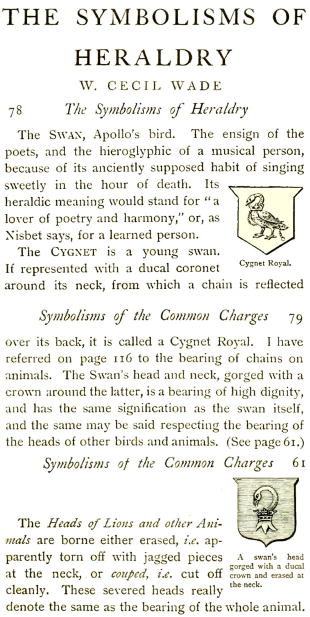
- The origin of armorial bearings; page 11.
- The symbolic side of heraldry; page 13.
- Heraldic colors and metals; page 35.
- The furs of heraldry; page 38.
- The meaning of heraldic lines; page 40.
- The symbolisms of the ordinaries; page 43.
- The division lines of the shield; page 55.
- The colors of the common charges not symbolical, chapter with 2 paragraphs only; page 57.
- Symbolisms of the common charges; page 59.
- Crowns, mitres, episcopal hats, etc.; page 138.
- Examples of symbolisms of colors and armorial bearings; page 149.
- Cadency and differencing; page 154.
- Alphabetic index; page 162.
Bibliographical reference of century XIX.
Classification: Symbolism, In black and white and English language.
Author: Wade, William Cecil.
The following article cites this bibliographic reference:
External resource:
Internal resources: WadeWC1898.SymbolismsHeraldry.pdf.

Continue with: Emblemata; 2002.
-
Language
-
Categories of heraldry
-
Divisions of the field
- Without divisions
- Party per pale
- Party per fess
- Party per bend
- Party per bend sinister
- Tierce
- Tierce sinister
- Tierced per fess
- Tierced per bend
- Tierced pallwise inverted
- Quarterly
- Quarterly per saltire
- Gyronny
- Party per fess, the chief per pale
- Party per pale, the sinister per fess
- Party per fess, the base per pale
- Party per pale, the dexter per fess
- Chapé
- Chaussé
- Party per chevron
- Enté en point
- Flanched
-
Metals
-
Colours
-
Furs
-
Other tinctures
-
Ordinaries and sub-ordinaries
-
Diminutives of the ordinaries
-
Other charges
-
Charges from Nature
Water, Eagle, Bald eagle, Eagle claw, Dorsal fin, Tail fin, Two hands clasped, Lark, Tree, Trunk, Rainbow, Atom, Barbel, Acorn, Bighorn sheep, Arm, Owl, Vulture, Horse, Head, Goat, Camellia, Thistle, Merino ram, Kapok tree, Stag, Doe, Crescent, Increscent, Chrysanthemum, Tail, Tail addorsed, Ermine spot, Hummingbird, Snowflake, Heart, Roe deer, Neck, Roe deers' attires, Raven, Dolphin, Diamond, Tooth, Elephant, Emerald, Starling, Mullet, Mullet of four points, Star of David, Estoile, Male figure, Fleur de lis, Flower, Cornflower, Dogwood flower, Lotus flower, Hop cone, Bluebonnet, Puffin, Ash, Rooster, Claw, Talon, Goose, Heron, Seagull, Pomegranate, Sunflower, Swallow-tail, Falcon, Leaf, Boar, Goldfinch, Laurel, Barn owl, Lion, Lioness, Lion passant, Leopard, Lion rampant guardant, Lynx, Lily, Madonna lily, Flame, Wolf, She-wolf, Parrot, Moon, Hand, Apple, Apple tree, Sea, Martlet, Wing, Two wings in vol, Covert, Blackbird, Mount, Trimount, Fly, Wrist, Elm, Olive tree, Orbital, Bear, Palm frond, Palm tree, Dove, Poplar leaf, Panther, Jaguar, Vine, Paw, Forepaw, Foot (palmiped), Foreleg, Peacock, Chest, Pelican, Pelican in her piety, Dog, Brach hound, Warren hound, Fish, Hoof, Beak, Quill, Cinquefoil, Quetzal, Branch, Sprig, Frog, Shamrock, Caboshed, Oak, Holm oak, Rose, Double rose, Savage, Serpent, Plough of Ursa Major, Sun, Sun in splendour, Ray of the sun, Lightning flash, River, Stem, Badger, Tyger, Linden, Wheat, Wheat spike, Bull, Tulip, Udder, Escallop and Fox.
-
Artificial charges
Halberd, Plough share, Ace of spades, Anchor, Cyclamor, Torch, Bow, Arch, Harp, Non-classic artifact, Winnowing fan, Crozier, Conductor's baton, Pair of scales, Ship, Oar, Sail, Norman ship, Beret, Grenade, Ecclesiastical cap, Arm vambraced, Knight, Chain, Covered cup, Monstrance, Bell, Bell tower, Cannon dismounted, Carbuncle, Castle, Ribbon, Clarion, Nail, Cord, Dagger, Key ward, Turret, With a turret, Armillary sphere, Sword, Federschwert, Sabre, Parchment, Scroll, Arrow, Club, Garb, Sheaf of tobacco, Scythe, Gauntlet, Axe, Buckle, Galician granary, Polish winged hussar, Church, Oil lamp, Spear, Spear's head, Fleam, Letter, Book, Open book, Closed book, Bookmark, Page, Line, Lantern, Key, Four crescents joined millsailwise, Hammer, Menorah, Mortar, Pestle, Number, Knot, Celtic Trinity knot, Water-bouget, Comb, Piano, Millstone, Millrind, Millwheel, Clay pot, Bridge, Cuffed, Hourglass, Chess rooks, Compass rose, Rosette of acanthus leaves, Mullet of six points pierced, Broken, Portcullis, Wheel, Wagon-wheel, Symbol, Sackbut, Drum, Geometric solid, Tetrahedron, Tower, Trident, Trumpet, Double vajra and Anvil.
-
Immaterial charges
Angel, Archangel, Basilisk, Heart enflamed, Sacred Heart of Jesus, Paschal lamb, Dragon, Wyvern, Phoenix, Garuda, Griffin, Sea-griffin, Winged hand, Our Lady of Mercy, Pegasus, Saint George, Mermaid, Trinity, Triton, Golden fleece, Unicorn and Ouroboros.
-
External elements
-
Heraldic creations
-
References
-
Formats
-
Keywords on this page
Watercolor, Point upwards, Pointed, Armorial roll, Azure, Bibliography, Five, Party per fess, Created, Outlined in sable, In black and white, In color, In fess, Coat of arms, Sword, Fleur de lis, Personal, Gules, Illuminated, Castilian language, English language, Manuscript, Martos García, Juan Carlos, Or, Argent, Without divisions, Kingdom of France, Kingdom of England, Magazine, Semé, Century XIII, Century XIX, Century XX, Century XXI, Symbolism, Vairy, Video, Helm and Index.